
Italian postcard by Vettori, Bologna, no. 2089. Photo: United Artists. Publicity still for The Son of the Sheik (George Fitzmaurice, 1926).
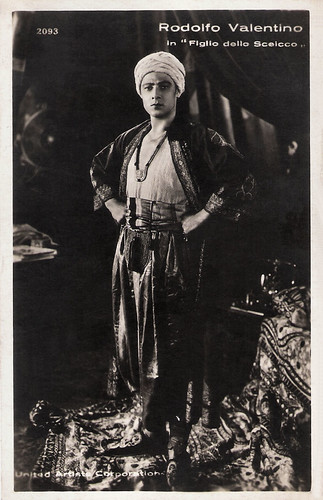
Italian postcard by Vettori, Bologna, no. 2093. Photo: United Artists. Publicity still for The Son of the Sheik (George Fitzmaurice, 1926).
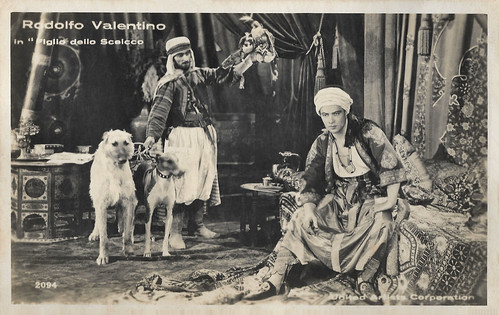
Italian postcard by Vettori, Bologna, no. 2094. Photo: United Artists. Publicity still for The Son of the Sheik (George Fitzmaurice, 1926).
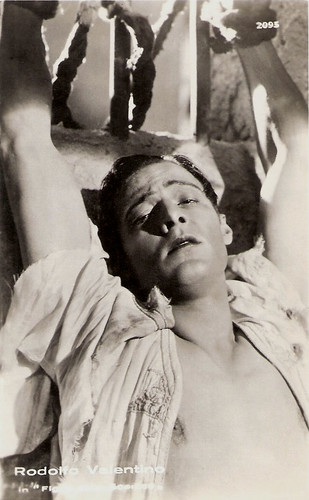
Italian postcard by Vettori, Bologna, no. 2095. Photo: United Artists. Publicity still for The Son of the Sheik (George Fitzmaurice, 1926).
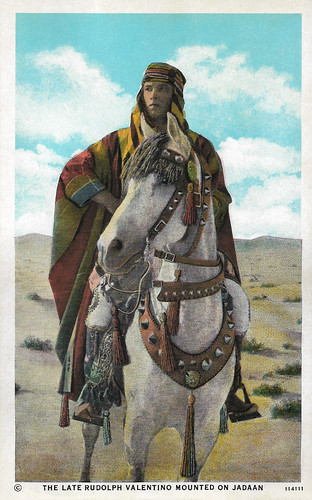
American postcard by Curt Teich & Company, inc., Chicago, no. 114111. Photo: United Artists. Publicity still for The Son of the Sheik (George Fitzmaurice, 1926). Captions: The late Rudolph Valentino mounted on Jadaan. This picture was taken at the time of filming the famous photoplay The Son of the Sheik in which the late Rudolph Valentino, with Jadaan as his mount, achieved notable success. Jadaan was the last horse ridden by Valentino. Jadaan, a beautiful Arabian stallion, was used in the picture courtesy of W. K. Kellogg owner of the W. K. Kellogg Arabian Horse Ranch, Pomona, Calif. Mr. Kellogg is a well-known Cereal Manufacturer in Battle Creek, Michigan.
A secret love, torture and revenge
The Son of the Sheik (George Fitzmaurice, 1926), is situated 'Not East of Suez, but South of Algiers', as we read in the opening title. In fact, the city of Touggourt in the south of Algiers is the location. In the marketplace, Ahmed (Rudolph Valentino), the handsome son of Sheik Ahmed Ben Hassan meets a dancing girl, Yasmine (Vilma Bánky). The two fall in love, and every night he travels from his desert camp to see her again and again.
Yasmine is the daughter of renegade Frenchman Andre (George Fawcett), who is the leader of a group of entertainers and criminals. By dancing publicly, Yasmine fronts her father's gang of cutthroats. Among the gang members is the villainous moor Gahbah (Montague Love), "whose crimes outnumber the desert sands" and to whom Yasmin is promised.
In the ruins near Touggourt, Yasmine and Ahmed meet secretly. During a rendezvous under the moonlight, Ahmed is suddenly caught and robbed by Gahbah and his gang. The gang holds Ahmed captive in a building where he hangs by his tied-up wrists placed on the window bars. He is tortured with a whip for not revealing the name of his father or any other information. Gahbah poisons Ahmed, telling him that Yasmin is bait to lure victims for them.
The young prince is freed by his trusted servant Ramadan (Karl Dane), who takes him to a friend's home to recover. Ahmed now believes that Yasmin has betrayed him. He seeks revenge and takes her by force to his desert camp. Ahmed subjects her to his methods of torture, with one scene looking at Yasmin with vengeance in his eyes, and (off camera) raping her. When his father takes his son home to fulfil a marriage agreement, Ahmed Ben Hassan orders him to release the girl.
Bitterly chastised by his father, Ahmed learns the truth about the innocent Yasmin from Ramadan, who has just escaped from Gahbah and his gang. The young prince tries to win back Yasmin. She has returned to the dance hall and does not want to have anything to do with him anymore. In the dance hall, a fight breaks out with the gang of criminals and Ahmed tries to rescue Yasmin from Gahbah. Finally, he chases them into the desert and saves the girl. And of course, all is forgiven in the end.
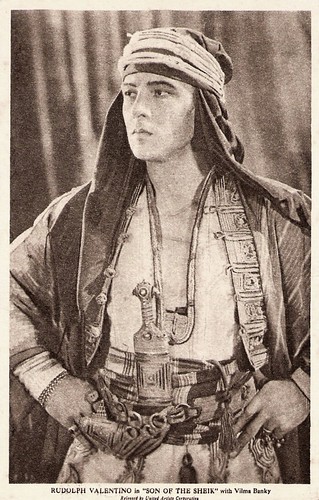
British postcard for Butywave Shampoo. Photo: United Artists. Publicity still for The Son of the Sheik (George Fitzmaurice, 1926).

French postcard in a series by Shampoing Butywave. Photo: Allied Artists. Publicity still of Rudolph Valentino in The Son of the Sheik (George Fitzmaurice, 1926).
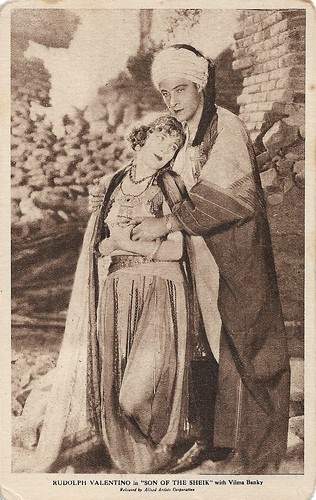
French postcard in a series by Shampoing Butywave. Photo: Allied Artists Corporation. Publicity still of Rudolph Valentino and Vilma Bánky in The Son of the Sheik (George Fitzmaurice, 1926).
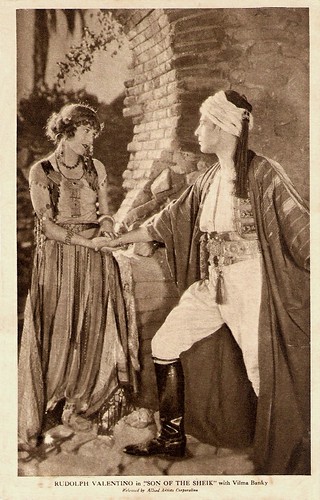
French postcard in a series by Shampoing Butywave. Photo: Allied Artists. Publicity still for The Son of the Sheik (George Fitzmaurice, 1926).
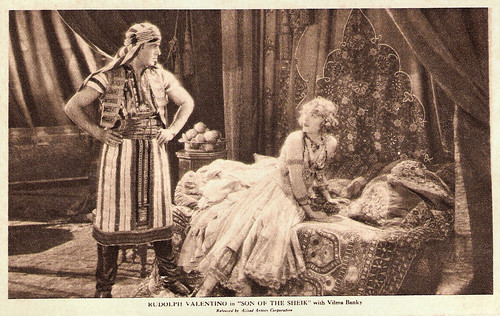
French postcard in a series by Shampoing Butywave. Photo: Allied Artists. Publicity still of Rudolph Valentino and Vilma Bánky in The Son of the Sheik (1926).
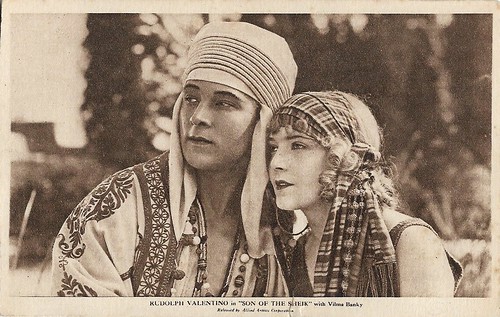
French postcard in a series by Shampoing Butywave. Photo: Allied Artists. Publicity still of Rudolph Valentino and Vilma Bánky in The Son of the Sheik (George Fitzmaurice, United Artists 1926).
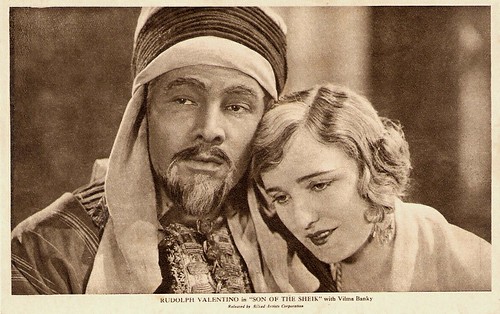
French postcard in a series by Shampoing Butywave. Photo: Allied Artists. Publicity still for The Son of the Sheik (1926). Despite the card telling this is Banky, the lady in question is Agnes Ayres. Ayres and Valentino play the parents of the leading character, also played by Valentino. Actually, the parents are the former protagonists of the earlier film The Sheik, now grown older.
A success beyond anyone's wildest dreams
The Son of the Sheik (George Fitzmaurice, 1926) was Rudolph Valentino's last film. It was a sequel to his earlier success, The Sheik (George Melford, 1921), in which he had played the impassioned lover who is initially impetuous, self-centred and brutal, but who gradually matures into an admirable man. The box office hit The Sheik solidified Valentino's image as 'the Great Lover'. In many ways, however, The Son of the Sheik is a much more interesting story than its predecessor. The film has a lighter tone that allows some humour as well as a lot more action. Sequels were rare in the silent era. Earlier, Douglas Fairbanks had followed his popular adventure film The Mark of Zorro (Fred Niblo, 1920) with the sequel Don Q, Son of Zorro (Donald Crisp, 1925). In The Son of the Sheik, the male lead is also the son of the original sheik. In the sequel, Valentino plays a stronger and more nuanced version of his signature role. He portrays both the son and his now middle-aged father, who is wiser but still commanding and able to wield a sword.
Agnes Ayres, Valentino's leading lady in The Sheik (1921), got special billing in the opening credits, and re-enacted her original role as Diana, this time as wife and mother. She makes the transition to worried mother effortlessly. The Son of the Sheik reunited Valentino with Vilma Bánky, with whom he had co-starred in The Eagle (Clarence Brown, 1925). He had personally picked her as his leading lady, and there is fine chemistry between them. The beautiful Banky dances magnificently well and has a great interpretation of her role. The famous erotic scene where Valentino ravishes her is one of the highlights of the film. Another striking (and homoerotic) sequence is the one in which Valentino, tied up, his tailored white shirt torn to shreds, is subject to a prolonged whipping by the gang of thieves. The most sadistic of them address him as "My young lion." Also memorable are Montagu Love in his role as the villain, the sandy sets with production designs by William Cameron Menzies and the impressive cinematography by George Barnes. Barnes executed the shots of the two characters played by Valentino in the same frame - even touching each other - flawlessly.
The Son of the Sheik is for all Rudolph Valentino's film. His burning stare and fetching smile made many filmgoers swoon, and the pure raw sensuality that Valentino portrays in this film is still exciting. He is excellent from start to finish and shows real talent in portraying both the son and the father. Valentino is very charming as the son and manages to be funny in his own right but the more impressive performance comes from the older father. Valentino is unrecognisable as the old sheik. Rudolph Valentino turned The Son of the Sheik into a rollicking and sexy adventure film, with adequate doses of humour. The swashbuckling scenes are exciting and well-choreographed. Frances Marion and Fred de Gresac had adapted Edith Maude Hull's novel Son of the Sheik for the screen. George Marion Jr. made the sometimes delicious tongue-in-cheek title cards. "The night was young at the Cafe Maure. Not a knife had been thrown, so far", one of his title cards reads.
The Son of the Sheik premiered at the Million Dollar Theater in Los Angeles on 9 July 1926. There it played for four weeks. Valentino then embarked on a nationwide tour to promote the film as it rolled out around the first-run theatres in the country's cities. On 15 August, he collapsed in his New York City hotel room and was rushed to the hospital. Doctors discovered he had a perforated ulcer which required emergency surgery. After the surgery, Valentino developed peritonitis and died on 23 August 1926. The Son of the Sheik was one of the first films to be released after its star's death. On 5 September 1926, nearly two weeks after Valentino had died, the film was put into general release nationwide. The Son of the Sheik grossed $1,000,000 within the first year of its release. Eventually, it more than doubled that. Who knows how far Valentino's film career would have gone had it not been for this untimely death at 31.
Hal Erickson concludes at AllMovie: "The finished film manages to convey a tongue-in-cheek, larger-than-life approach to its melodramatic material without ever actually making fun of that material or condescending to Valentino's legions of fans. Rudolph Valentino had made Son of the Sheik in hopes of boosting his slightly flagging career; while it succeeded beyond anyone's wildest dreams, Valentino, alas, had died just before the film was released."

French postcard in the Les Vedettes de Cinéma series by A.N., Paris, no. 243. Photo: United Artists. Publicity still of Rudolph Valentino in The Son of the Sheik (George Fitzmaurice, 1926).

French postcard in the Les Vedettes de Cinéma series by A.N., Paris, no. 244. Photo: United Artists. Publicity still of Rudolph Valentino in The Son of the Sheik (George Fitzmaurice, 1926).

French postcard by Europe, no. 232. Photo: United Artists. Publicity still for The Son of the Sheik (George Fitzmaurice, 1926).
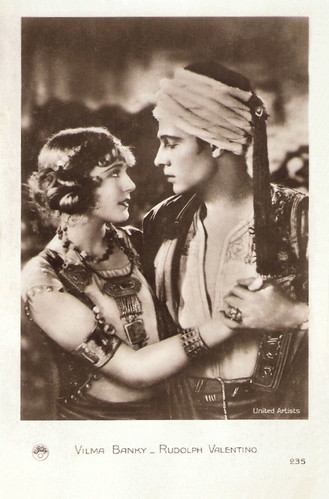
French postcard by Europe, no. 235. Photo: United Artists. Publicity still for The Son of the Sheik (George Fitzmaurice, 1926).
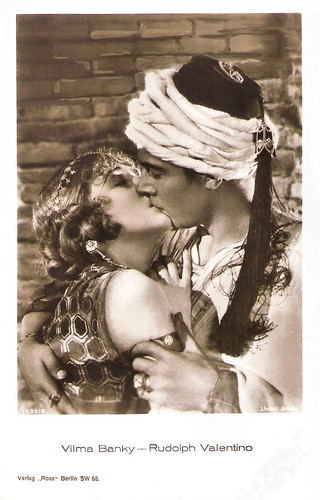
German postcard by Ross Verlag, no. 1535/2, 1927-1928. Distributed in Italy by Casa Editrice Ballerini & Fratini, Firenze. Photo: United Artists. Publicity still for The Son of the Sheik (George Fitzmaurice, 1926).
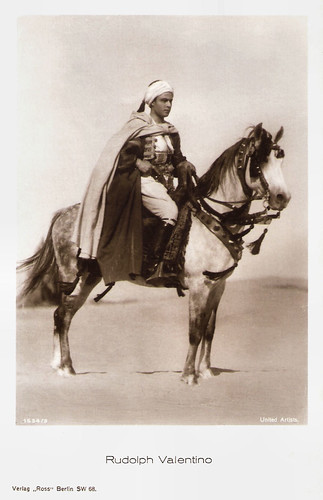
German postcard by Ross Verlag, no. 1534/3, 1927-1928. Photo: United Artists. Publicity still for The Son of the Sheik (George Fitzmaurice, 1926).
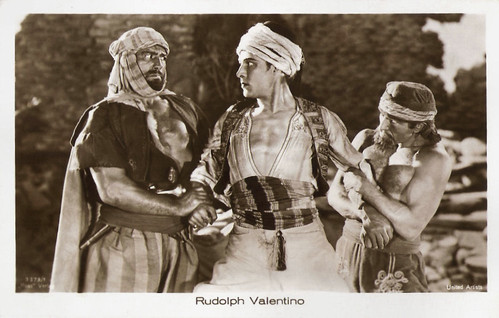
German postcard by Ross Verlag, no. 3373/1, 1928-1929. Photo: United Artists. Publicity still for The Son of the Sheik (George Fitzmaurice, 1926).
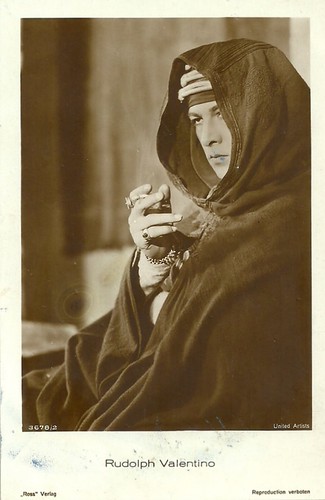
German postcard by Ross Verlag, no. 3678/2, 1928-1929. Photo: United Artists. Publicity still of Rudolph Valentino in The Son of the Sheik (George Fitzmaurice, 1926).

Dutch-German postcard by Ross Verlag, no. 3945/2, 1928-1929. Photo: United Artists. Publicity still for The Son of the Sheik (George Fitzmaurice, 1926). This vintage postcard contains Dutch text on the backside.
Sources: Hal Erickson (AllMovie), Wikipedia and IMDb.
This post was last updated on 30 April 2023.
No comments:
Post a Comment